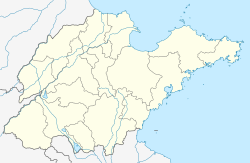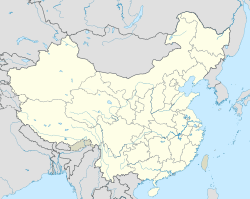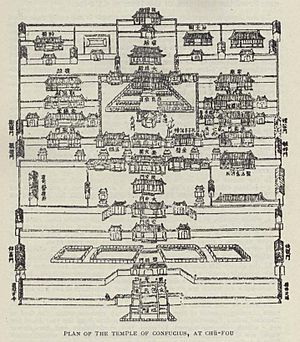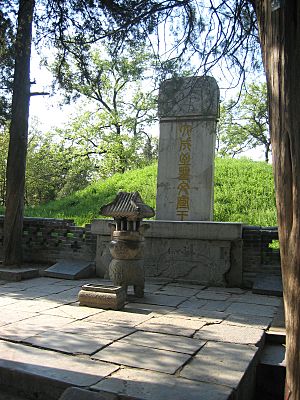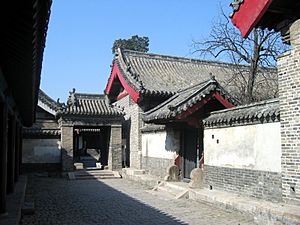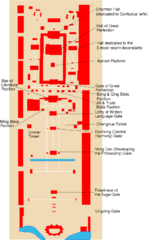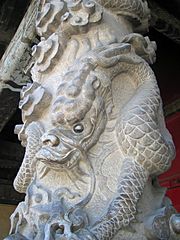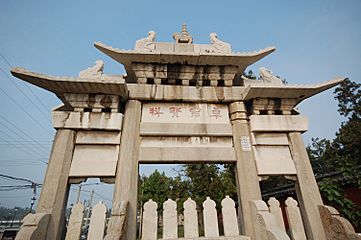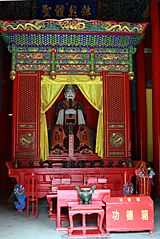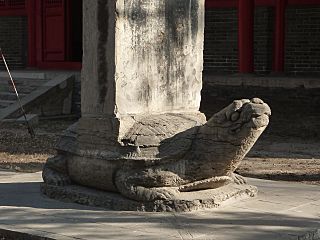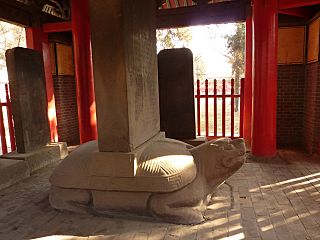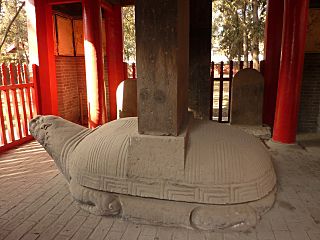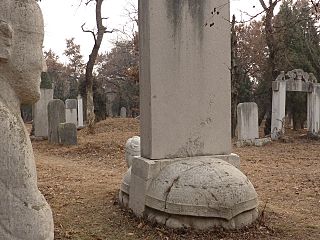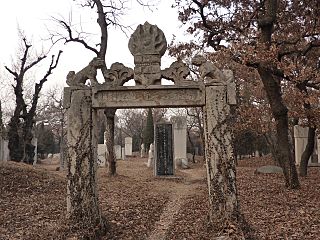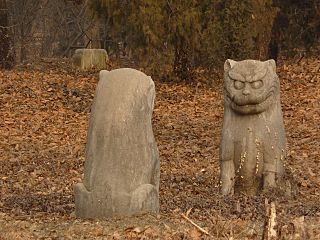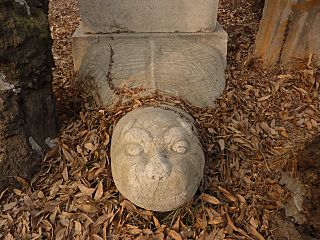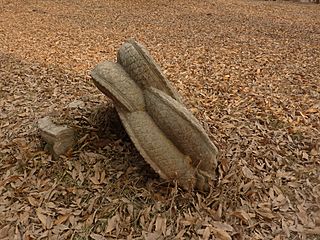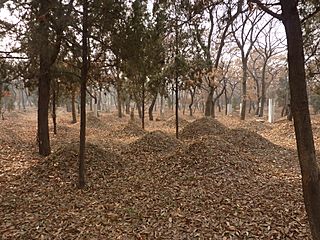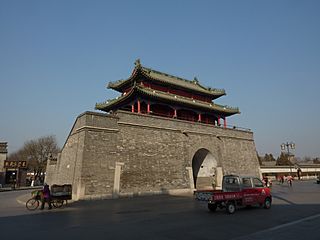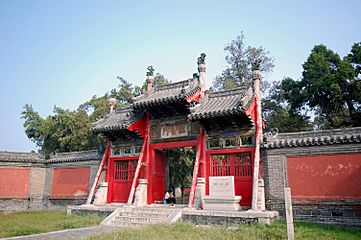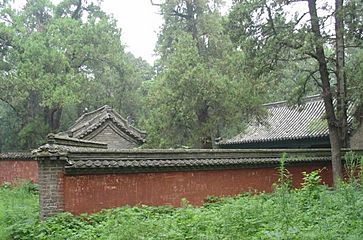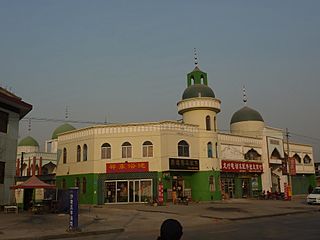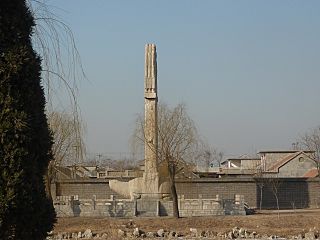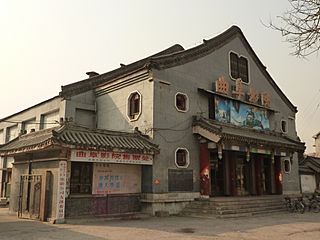Qufu facts for kids
Quick facts for kids
Qufu
曲阜市
Kufow
|
|
|---|---|
|
County-level city
|
|
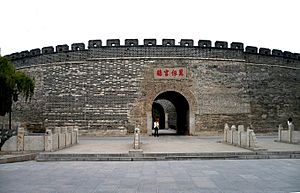
Qufu's south gate
|
|
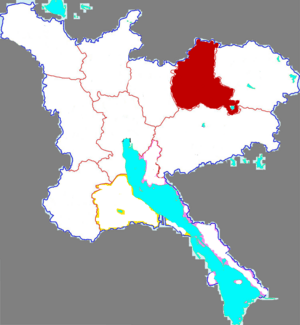
Location in Jining
|
|
| Country | People's Republic of China |
| Province | Shandong |
| Prefecture-level city | Jining |
| Area | |
| • County-level city | 815 km2 (315 sq mi) |
| Elevation | 65 m (214 ft) |
| Population
(2017)
|
|
| • County-level city | 653,000 |
| • Density | 801.2/km2 (2,075.2/sq mi) |
| • Urban | 188,000 |
| Time zone | UTC+8 (China Standard) |
| Postal code |
273100
|
| Qufu | |||||||||||||||||||||||||||||||||||||||||||
|---|---|---|---|---|---|---|---|---|---|---|---|---|---|---|---|---|---|---|---|---|---|---|---|---|---|---|---|---|---|---|---|---|---|---|---|---|---|---|---|---|---|---|---|

"Qufu" in Chinese characters
|
|||||||||||||||||||||||||||||||||||||||||||
| Chinese | 曲阜 | ||||||||||||||||||||||||||||||||||||||||||
| Postal | Kufow | ||||||||||||||||||||||||||||||||||||||||||
| Literal meaning | "Crooked Hill" | ||||||||||||||||||||||||||||||||||||||||||
|
|||||||||||||||||||||||||||||||||||||||||||
Qufu (pronounced Chü-fü) is a city in Shandong province, East China. It is about 130 kilometers (80 miles) south of Jinan, the provincial capital. Qufu covers 815 square kilometers (315 square miles). About 653,000 people live there, with 188,000 in the city area.
Qufu is famous as the birthplace of Confucius. He was a very important Chinese thinker and teacher. Many historic buildings, temples, and cemeteries are in Qufu. The three most famous places are called San Kong, meaning "the Three Confucian Sites". These are the Temple of Confucius, the Cemetery of Confucius, and the Kong Family Mansion. Since 1994, these three sites have been a UNESCO World Heritage Site. In 2015, Qufu also became an International Cittaslow city, which means it promotes a slow-paced, high-quality life.
Contents
What's in a Name?
The name Qufu means "crooked hill." This name comes from a mile-long hill that was part of the city long ago. This was when Qufu was the capital of the ancient state of Lu.
A Look at Qufu's Past
| UNESCO World Heritage Site | |
|---|---|
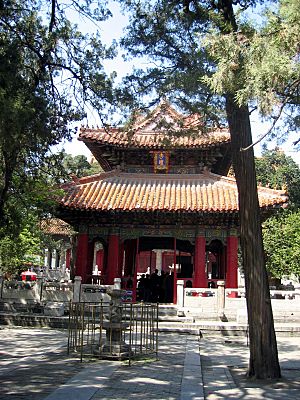
Apricot Platform in the Confucius Temple
|
|
| Criteria | Cultural: i, iv, vi |
| Inscription | 1994 (18th Session) |
Qufu has a very long history. During the Shang dynasty, the area was home to the Yan people. They were seen as "Eastern Barbarians" by the Chinese. Around 1042 BC, the Yan people joined a rebellion against the Duke of Zhou. After the rebellion failed, the Duke took control of their land. This land became part of the state of Lu, and Qufu was its capital. The city walls back then were much bigger than the ones you see today.
Over time, the city's location changed. In 1012 AD, during the Song dynasty, Qufu was renamed Xianyuan County. It moved about 4 kilometers (2.5 miles) east of its current spot. This new location was near the supposed birthplace of the legendary Yellow Emperor. A temple was built there for him.
Later, in 1142, the Jin dynasty changed the name back to Qufu. But the city stayed in its Song dynasty location. The city walls you see today were built much later, in 1522, during the Ming dynasty. The old Song dynasty city site is now a village called Jiuxian.
During the Southern Song dynasty, a descendant of Confucius named Kong Duanyou moved south. But his brother, Kong Duancao, stayed in Qufu. This led to two branches of the Kong family, each with a special title called Duke Yansheng. Later, the northern branch in Qufu kept the title.
In 1966, during the Cultural Revolution, Qufu's historical sites were badly damaged. Students and staff from Beijing Normal University destroyed thousands of artifacts. They also damaged many ancient trees and graves. This was part of a movement to destroy "Four Olds" (old ideas, culture, customs, and habits).
Before the modern way of writing Chinese (Pinyin) was used, Qufu's name was spelled in many different ways in English. Some examples include Ch'ü-fou-hien, Kufow, and Chufou.
Qufu's Layout
The old part of Qufu is surrounded by a restored city wall and moats. The Drum Tower is in the middle of this walled city. The Temple of Confucius, Confucius Mansion, and the Temple of Yan Hui are all inside the walls.
The Cemetery of Confucius is about 1.3 kilometers (0.8 miles) north of the walled city. The modern downtown area is south of the old city. There is also a mosque and a lively Muslim area just outside the west gate.
On the eastern side of Qufu, you'll find the train station and industrial areas. The Shaohao Tomb and the Shou Qiu historical site are also in the eastern outskirts. The Si River and the Yi River both flow through Qufu.
Weather in Qufu
Qufu has a climate with warm, wet summers and cold, dry winters. On average, it gets about 666.3 millimeters (26.2 inches) of rain each year. The average yearly temperature is 13.6°C (56.5°F).
Getting Around Qufu
Train Travel
The old Beijing–Shanghai railway passes through Qufu. For many years, people used the train station in Yanzhou, about 15 kilometers (9 miles) west.
A smaller railway, the Yanshi Railway, also goes through Qufu. It has a small passenger station on the southeast side of the city.
In 2011, the fast Beijing–Shanghai high-speed railway opened. Its Qufu East railway station is a few kilometers southeast of the city. Another high-speed train station, Qufu South railway station, opened in 2021.
Road Travel
Two major national highways, China National Highway 104 and China National Highway 327, go through Qufu.
Monorail Project
A monorail project was started in 2017 to connect Qufu and Zoucheng. It was planned to be 12 kilometers (7.5 miles) long with 12 stations. However, construction was stopped. Local officials hope to finish the line in the future.
Temple of Confucius (Kong Miao)
The Temple of Confucius is a very important place. Just two years after Confucius died, his home in Qufu became a temple. In 205 BC, the first emperor to visit and honor Confucius here was Liu Bang of the Han dynasty. Many emperors and officials followed his example.
Over the centuries, the temple grew much larger. It was damaged by fire and war many times but was always rebuilt. In 1499, after a big fire, it was rebuilt to its current size. This was around the same time the Forbidden City was built in Beijing. Because of this, the temple's design looks a lot like the Forbidden City.
The temple complex is the second largest historical building complex in China. It covers 16,000 square meters (about 4 acres) and has 460 rooms. The main part has 9 courtyards along a central path that is 1.3 kilometers (0.8 miles) long. The first courtyards have small gates and tall pine trees. The first gate is called "Lingxing Gate," suggesting Confucius is like a star from heaven.
The main buildings have yellow roof-tiles and red walls, colors usually used for the emperor. They are surrounded by dark green pine trees. The most important building is the Dacheng Hall, or "Great Perfection Hall." It is 54 meters (177 feet) long and 34 meters (112 feet) wide, and almost 32 meters (105 feet) tall.
The hall is supported by 28 large pillars, each 6 meters (20 feet) high. Ten of these pillars have carved dragons. People say these dragon pillars were covered when the emperor visited so he wouldn't get jealous! Dacheng Hall was where people offered sacrifices to Confucius. In front of the hall is the "Apricot Platform." This marks the spot where Confucius taught his students under an apricot tree. Every year on September 28, a ceremony is held here to celebrate Confucius's birthday.
Cemetery of Confucius (Kong Lin)
The Cemetery of Confucius is north of Qufu. It holds the oldest graves dating back to the Zhou dynasty. Confucius's original tomb was shaped like an axe. Today, his tomb is a cone-shaped hill. Over time, tombs for his many descendants were added around his.
Confucius's descendants were given important titles and married imperial princesses. So, many tombs in the cemetery show symbols of noble status. There are about 3,600 tombstones from the Song dynasty, Yuan dynasty, Ming dynasty, and Qing dynasty.
In 1331, work began on the cemetery wall and gate. The cemetery has been renovated and expanded 13 times. By the late 1700s, the wall was 7.5 kilometers (4.7 miles) long. It encloses an area of 3.6 square kilometers (1.4 square miles). More than 100,000 descendants of Confucius are buried here. The oldest graves are from the Zhou dynasty, and the newest are from the 76th and 78th generations of the family.
During the Cultural Revolution, the cemetery was damaged. Tombs were dug up, looted, and flattened. Confucius's statue was pulled down. Many ancient texts were burned, and thousands of artifacts were destroyed or damaged. Over 5,000 ancient pine trees were cut down.
Today, more than 10,000 mature trees make the cemetery look like a forest. A straight road, 1266 meters (4154 feet) long, leads from Qufu's north gate to the cemetery. It is lined with cypress and pine trees. Along this road is the Temple of Yan Hui, dedicated to Confucius's favorite student.
Kong Family Mansion (Kong Fu)
The Kong Family Mansion is where the direct descendants of Confucius lived. It is located east of the Temple of Confucius. The family was responsible for taking care of the temple and cemetery. They also performed important religious ceremonies for things like harvests and birthdays. The Kong family owned the largest private estate in China.
The first mansion was built in 1038 during the Song dynasty. It was rebuilt and moved in 1377 by the first Ming dynasty emperor. In 1503, it was expanded to 560 rooms and 9 courtyards, just like the Confucius Temple. The mansion was fully renovated in 1838 but burned down in 1887. It was rebuilt two years later, with the emperor paying for the costs.
Today, the mansion has 152 buildings and 480 rooms, covering 12,470 square meters (3.1 acres). Its tallest building is a four-story refuge tower. This tower was meant to be a shelter during attacks, but it was never used. Confucius's descendants lived in the mansion until 1937. They left during the Second Sino-Japanese War and later moved to Taiwan. The head of the family still lives there today.
The mansion's design is traditional Chinese. It separates the official rooms in the front from the family living areas in the back. The way the buildings are arranged shows the Confucian idea of order and respect for age and status. For example, the oldest descendant of Confucius lived in the main building, while his younger brother lived in a building to the east.
Qufu's Economy
Qufu's economy includes several industries. Farming, especially growing grains, is very important. Other main industries are food processing, textiles, building materials, chemicals, and coal mining. Qufu also makes paper and industrial machines. Tourism is a big part of the economy too. The city holds many cultural festivals and exhibitions, mostly focused on Confucius.
Natural Resources
Qufu has deposits of important minerals. These include coal, phosphorus, and limestone.
Learning in Qufu
Qufu Normal University is located in Qufu. It also has another campus in Rizhao. The university started in 1955. It offers many different study programs, including 87 undergraduate majors, 25 master's degrees, and 11 doctoral degrees.
Religion in Qufu
Qufu is a traditional center for Confucianism. This is because Confucius was born here. The city is home to the holiest Temple of Confucius. It also has the Mausoleum of Confucius and the Mansion of the Kong Family. Qufu also has a branch of the Holy Church of Confucius and is the main office for the Federation of Confucian Culture.
Gallery
- The Temple of Confucius
- The Temple of Yan Hui
-
Stele in memory of rebuilding the temple, Year 9 of Zhizheng era (1349)
-
Stele in memory of rebuilding the temple, Year 6 of Zhengtong era (1441)
-
Stele in memory of rebuilding the temple, Year 4 of Zhengde era (1509)
- The Cemetery of Confucius
- Other sights
See also
 In Spanish: Qufu para niños
In Spanish: Qufu para niños


